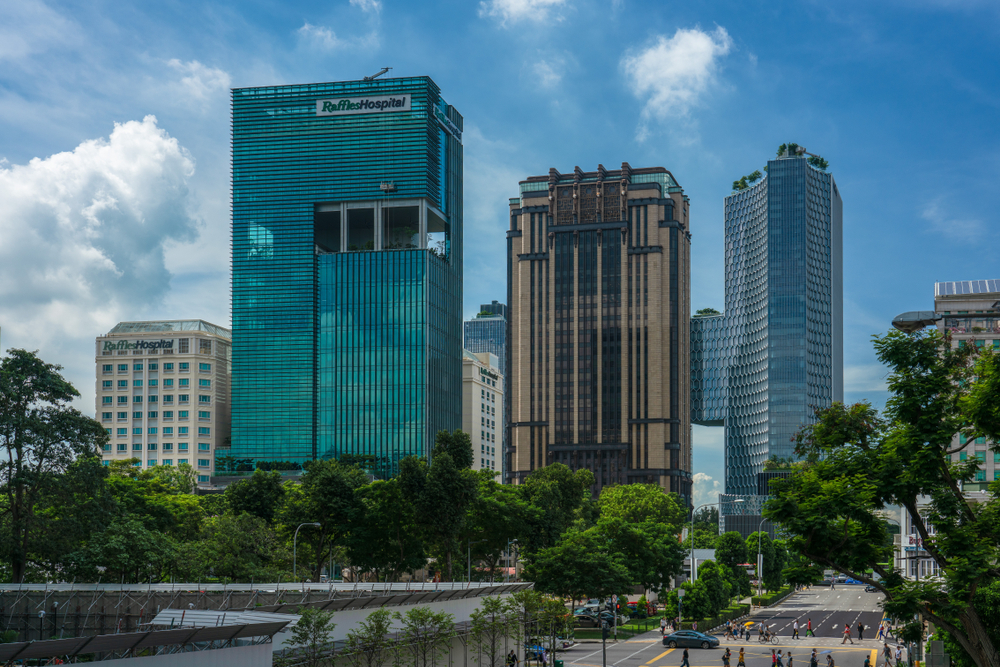What’s medical tourism?
As its name suggests, “medical tourism” is the combination of medical treatment and tourism. Due to the disparities in healthcare standards, prices and technology across different countries, if patients cannot access proper treatment locally, they may consider seeking medical treatment overseas.
This term may seem novel, but the industry has long been well underway. Since many years ago, celebrities have made special trips to other places for different treatments. And as the barriers to travel are on the ebb, medical tourism is becoming more prevalent.
According to GlobeNewswire, the global medical tourism market size is expected to exceed HK$280 billion in 2022. As the world recovers from the COVID-19 impact, local governments have begun to gradually ease entry and exit restrictions. It is believed that the total market value will continue to rise steadily and reach HK$430 billion in 2026.
Why is medical tourism popular?

There are three reasons for medical tourism is popular.
- Patients’ demand for quality medical services
Every patient wants to enjoy the best medical services. Given the effects of globalization, patients benefit from the greatly reduced cost of cross-border travel, which directly lowers the threshold for medical tourism. If local medical services are inadequate, patients are more likely to consider going overseas for medical treatment.
- The meteoric development of the Internet
Due to the rapid proliferation of the Internet, people can more readily obtain information about overseas medical services and even consult foreign doctors remotely to find out whether it is necessary for them to go abroad for treatment.
- Active promotions by local governments
Medical tourism not only helps patients get the best care for their needs but is also a considerable source of revenue for the local area. In order to seize the opportunity, the governments of many countries or regions have begun to develop international medical tourism services at full tilt in order to provide tourists with an exemplary environment for recuperation.
Take Thailand as an example, as one of the most popular medical tourism destinations, the local government is contemplating the possibility of easing visa restrictions and even gearing up to introduce an exclusive visa for medical tourists in order to afford overseas patients greater convenience.
Benefits of medical tourism
- Relatively lower medical costs
Many people consider seeking more affordable options in other countries because they cannot afford the high local medical costs. For example, Americans can save 30% to 90% on medical bills by going abroad for treatment.
- Higher quality of healthcare
The pace of medical development varies from country to country. India, for example, is particularly good at heart surgery, while South Korea is internationally acclaimed for treating spinal cord injury and associated complications.
- More comprehensive medical insurance
In view of the strong market demand for medical tourism, a growing number of insurance providers are offering coverage worldwide, expanding coverage to include qualified medical expenses both at home and abroad.
- Shorter waiting time
Even though some areas have adequate healthcare, patients may not be able to receive appropriate diagnosis and treatment within a reasonable period of time due to excessively long waits. Take Hong Kong as an example, the waiting time for joint replacement surgery in public hospitals can be up to four years.
- The joy of travel
Although the focus of medical tourism is getting medical treatment, it is nevertheless a golden opportunity to travel abroad. Many patients choose to arrive at their destination early. Before the actual surgery, they would visit the famous local scenic spots for sightseeing and to revel in the exotic atmosphere. Alternatively, they would stay on for a period of time following the surgery to travel as well as recuperate.
- Evade local medical restrictions
Certain medical procedures may be illegal in some countries such that patients who want to receive them have to go abroad for treatment.
Global Popular Medical Tourism Destinations
- Thailand
In tandem with its stable economic development, Thailand’s healthcare services have become quite popular in recent years. Not only did Thailand rank fifth in the “Global Health Security Index 2021” but as many as 66 hospitals across the country—the largest number in the entire Southeast Asia region—have also passed the JCI assessment. The quality of Thailand’s medical services is indisputable.
The most popular medical procedures in Thailand are regenerative medicine, dental care, assisted reproduction and sex reassignment surgery. In addition, the local technology in cardiology and physical examination is also widely recognized, and prices are nearly 80% lower than those in developed countries.
- Singapore
Given its first-class medical standards and stunning urban scenery, Singapore has always been an internationally renowned medical tourism destination.
In 2003, leveraging its comprehensive tiered healthcare system, the Singapore government launched the “Medical Tourism Policy” to make a hit with medical tourists. At the same time, Singapore is also actively advancing in the medical technology space. 18 medical centers across the country are JCI-accredited, which helps build patients’ confidence in the local healthcare system.
Singapore offers a wide range of medical services, including, but not limited to orthopedic surgery, cardiac surgery, cancer treatment, ophthalmology and cosmetic procedures.
- India
India is also one of the popular destinations for medical tourism. India, along with Thailand and Singapore, account for a combined market share approaching 90%.
Seeing that India’s medical system has distinctively competitive advantages compared to advanced countries, the local government has been actively developing unique medical tourism packages in recent years, such as encouraging cooperation between hospitals and hotels to provide patients with an ideal environment for recuperation. In order to promote the development of medical tourism, India has been committed to easing the entry requirements for medical tourists and streamlining the procedures for foreigners to access medical services as much as possible.
The medical services most attractive to foreign tourists in India are replacement therapy, cardiac surgery, bone marrow transplantation and hip replacement surgery, which are highly rated internationally.
- Malaysia
Malaysia is arguably a rising star in medical tourism, attracting more than 1 million medical tourists in just one year, thanks to the excellent air connectivity, affordable hotel accommodations, and top-notch medical technology.
Data shows that the cost of treatment in Malaysia is nearly 65% to 80% cheaper than in the United States, Australia and Europe. In addition, the local Ministry of Health is committed to promoting the healthcare tourism industry and ensuring that medical tourists can enjoy high-quality medical services at fair prices. Thus, Malaysia is rapidly emerging as a world-class medical tourism destination.
Malaysia offers a wide range of medical and specialist services, including cardiology, orthopedics, pain management, orthopedics, oncology and physical examinations.
- South Korea
The quality of medical services in South Korea is also considered exceptional in Asia. Coupled with its comprehensive medical equipment and favorable immigration policies, South Korea possesses a robust global competitive advantage.
In 2009, South Korea introduced a special medical visa, allowing medical tourists to enter the counter via a more simplified route. This has successfully attracted many patients from neighboring countries to visit South Korea for medical treatment.
In addition to cosmetic surgery and dermatology, in South Korea, health examinations, gynecology, ophthalmology, dentistry, neurosurgery and traditional Korean medicine are also very popular with foreign tourists.
Common medical tourism treatments
Common medical tourism treatments include:
- Dental Care
- Surgery
- Diagnostics and Checkups
- Orthopedic Surgery
- Cardiac Surgery
- Eye Surgery
- Cosmetic Surgery
- Fertility Treatment
- Organ Transplantation
- Cancer Treatment
How to plan a medical tourism itinerary?
If you are interested in medical tourism, we recommend that you consult local and overseas doctors before you decide to set out. If you are concerned about the language barrier, you can consider using translation services provided by a medical tourism agency to conduct remote consultations with overseas doctors with the help of an expert. That way, you can obtain more comprehensive treatment information and advice on diagnosis and treatment.
After that, you need to verify the credentials of the medical institution, such as whether the institution is a hospital or a clinic, whether it is qualified to provide medical services to overseas tourists, whether it is certified to an international safety standard, etc., to ensure that you can receive high-quality medical treatment and care .
Finally, since foreign medical systems may not have your personal medical records at hand, before departure, you need to double-check the types of documents required by the foreign medical institutions, such as outpatient or inpatient medical records, medication history, physical examination results, etc., to prevent your treatment from being hampered due to missing documents.
Disadvantages/ Risk of Medical Tourism
- Communication challenges
Due to language and cultural differences between countries, patients may be misdiagnosed due to language barriers, or fail to make sense of the doctor’s words during follow-up visits, which can affect the progress of postoperative recovery.
Therefore, some hospitals specifically hire staff who are proficient in multiple languages to provide interpretation services for medical tourists. There are also many medical tourism agencies available that provide professional translation services for clients and appoint a medical nurse who speaks the local language to accompany and help patients facing communication issues.
- Potential legal loopholes
While medical tourism has many benefits, patients should also be aware of potential legal loopholes.
For example, since patients generally search for information through the Internet, if they accept certain false information as true, they may end up facing irrevocable losses. In the event of a medical accident, medical institutions may shirk their responsibilities because the patient is not a local. In other words, the patient may not be given reasonable compensation, and what’s more, it is difficult for the patient to advocate for their own rights and interests through the law.
- Continuity of care
If the patient undergoes a major surgery overseas, it generally takes considerable time to recover, and it is not advisable to take a plane or go out for fun immediately after the operation.
However, for patients with ordinary tourist visas, the length of their overseas stay may be limited. Chances are they might need to travel back and forth within half a year, which may affect the follow-up procedure and increase the risk of complications due to frequent changes of environment.
Comparison of charges for common medical tourism treatments
| Medical Treatment | USA (USD) | Singapore (USD) | Malaysia (USD) | South Korea (USD) |
| Coronary Artery Bypass Graft | 123,000 | 17,200 | 12,100💰 | 26,000 |
| Angioplasty | 28,200 | 13,400 | 8,000💰 | 17,700 |
| Heart Valve Replacement | 170,000 | 16,900 | 13,500💰 | 39,900 |
| Knee Replacement | 25,000 | 16,000 | 7,700💰 | 17,500 |
| Hip Replacement | 40,364 | 13,900 | 8,000💰 | 21,000 |
| Spinal Fusion | 110,000 | 12,800 | 6,000💰 | 16,900 |
| In Vitro Fertilization (IVF) | 12,400 | 14,900 | 6,900💰 | 7,900 |
| Uterine Prolapse Repair | 15,400 | 10,400 | 4,200💰 | 10,400 |
*💰 indicates the country with the lowest medical charges
** Charges in the above table are for reference only
- 1USA - Centers for Disease Control and Prevention, CDC
- 2New York Times - Why Medical Tourism Is Drawing Patients, Even in a Pandemic
- 3Globe News Wire
- 4Med Crave
- 5Consultancy.asia
- 6Health Care
- 7iMoney Malaysia
- 8Jade Land





